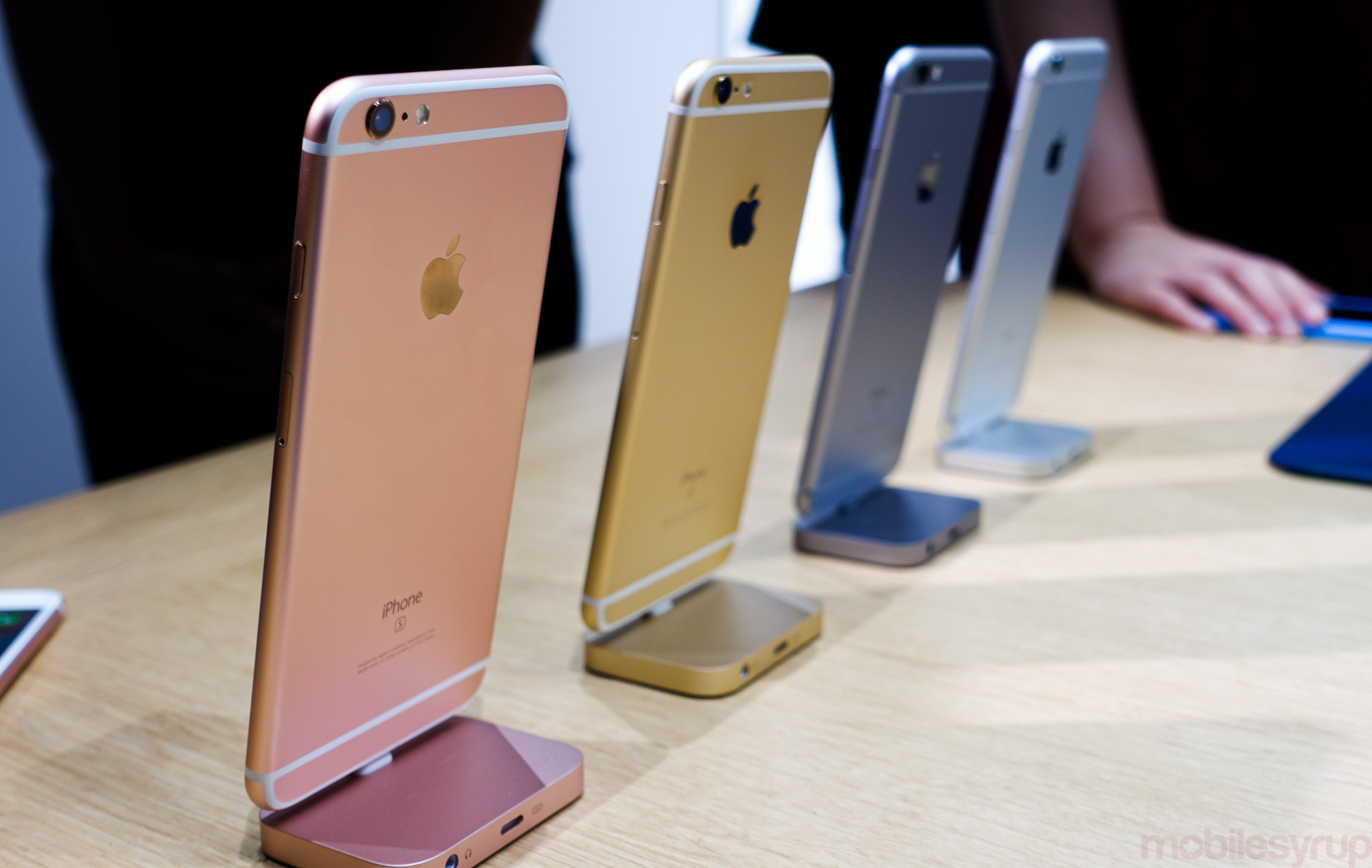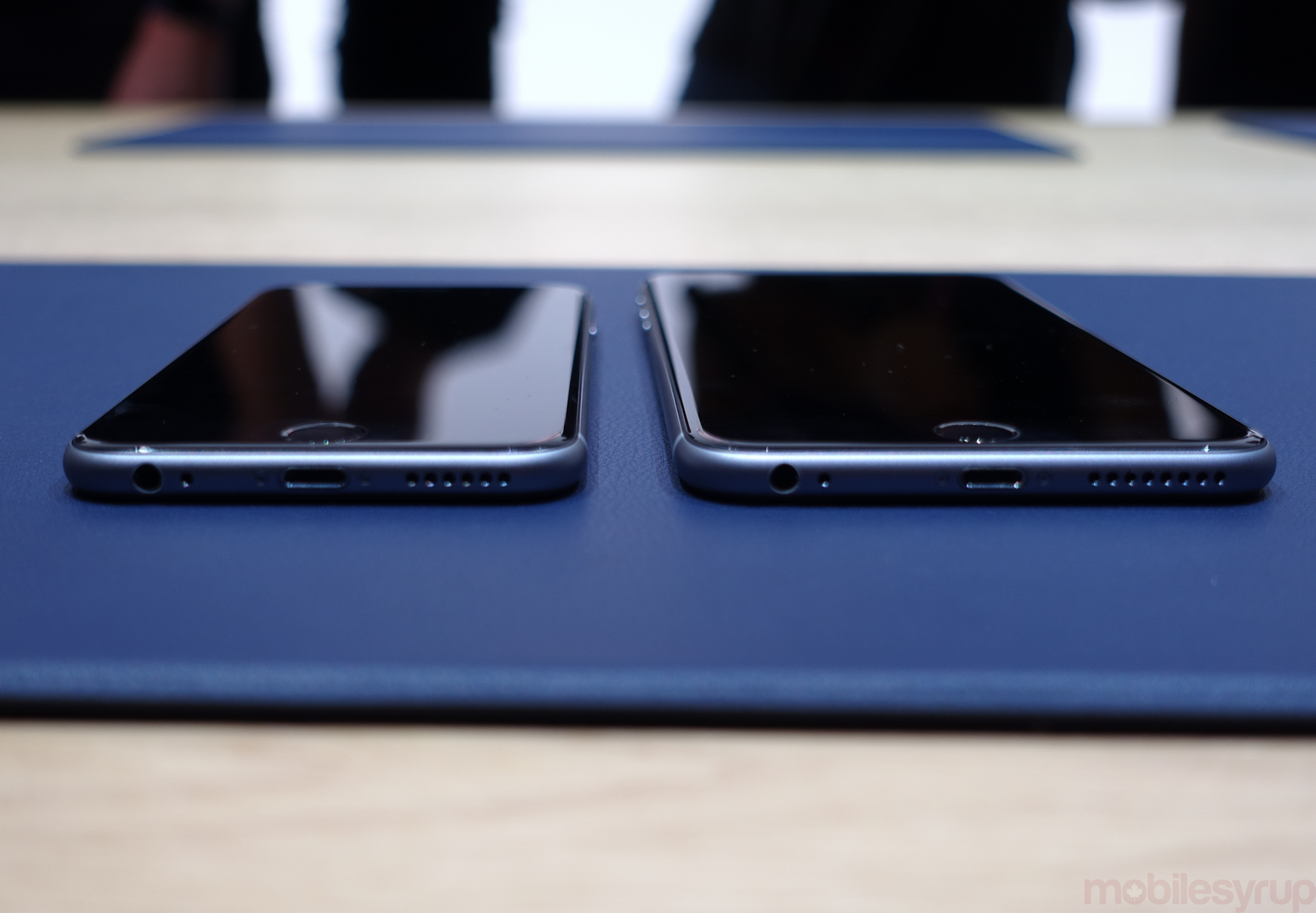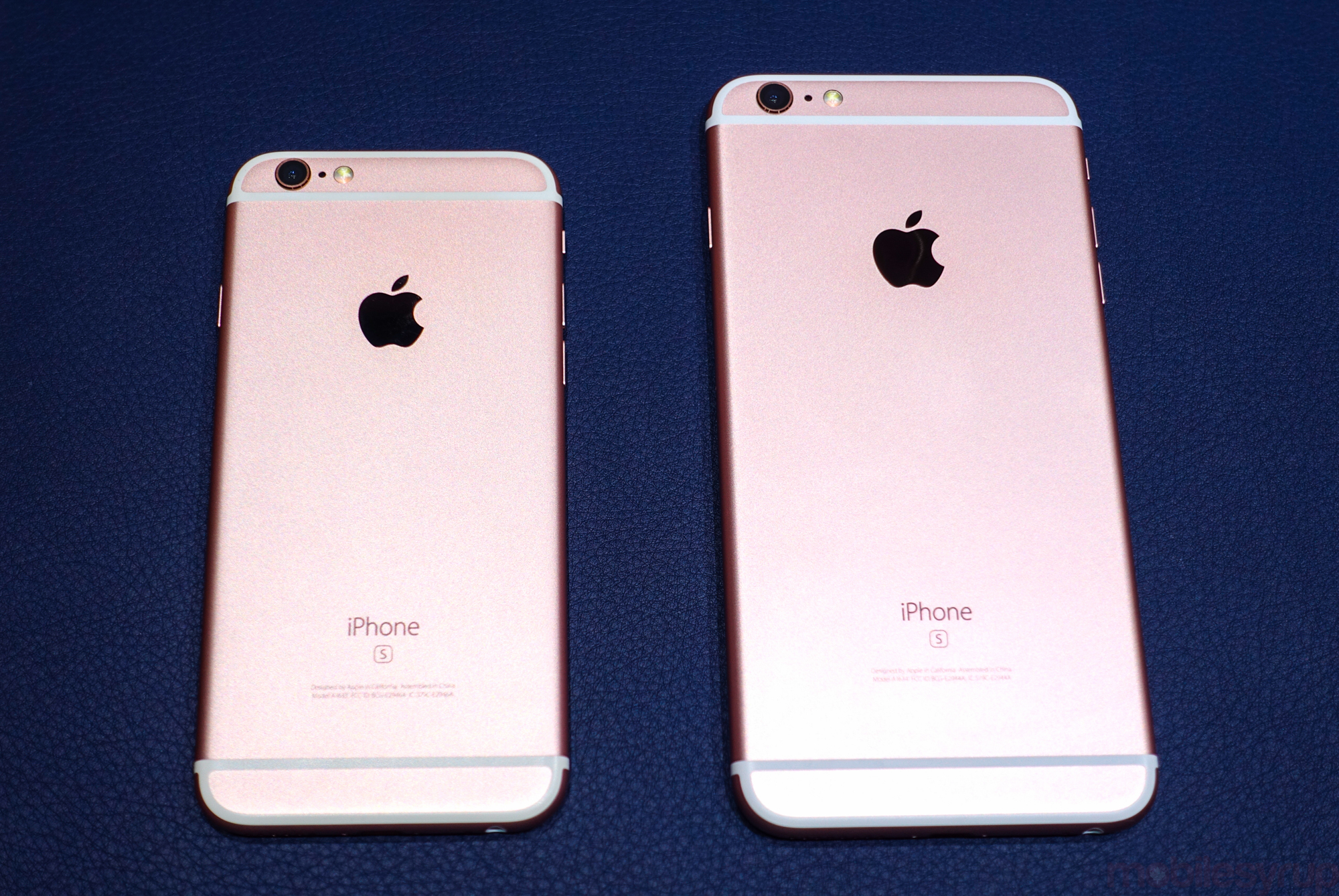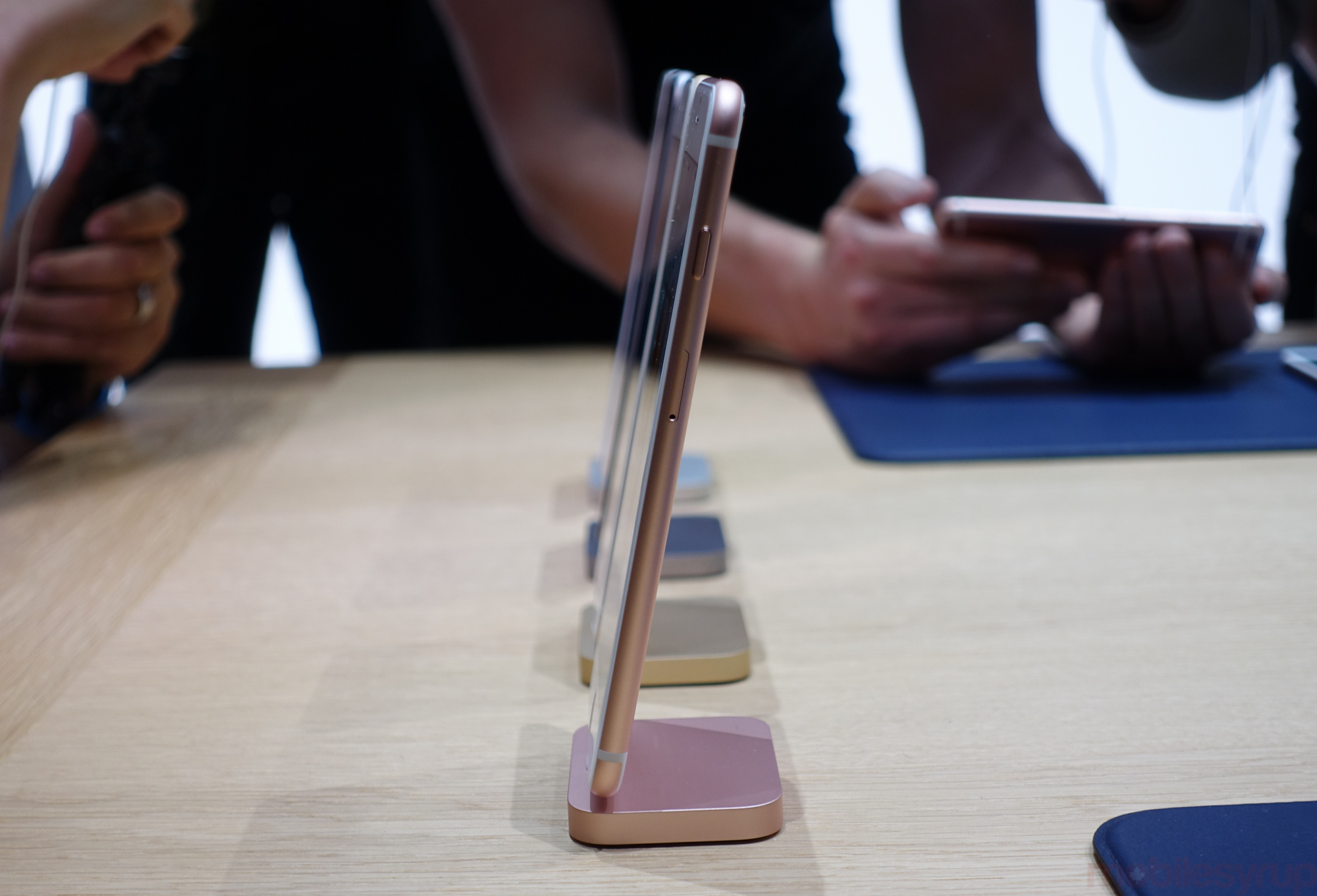
The iPhone 6s and iPhone 6s Plus weren’t exactly the stars of today’s Apple keynote — a four-product showcase that started with Apple Watch and transitioned to the iPad Pro, the brand new Apple TV and finally, Apple’s money maker, the iPhone — but it wasn’t without its surprises.

The phones, as expected, look and feel remarkably similar to last year’s iPhone 6 and 6s, a mainstay of Apple’s “tick-tock” smartphone strategy. But unlike the transition from the iPhone 4 to the 4s and the 5 to the 5s, the iPhone 6s and 6s Plus are actually thicker and heavier than their predecessors, crafted with a new type of aluminum to which Apple owns the patent.
Some of that heft is likely due to the new 3D Touch sensors hidden beneath the IPS display, but it’s just as likely that Apple wanted to avoid any conception that its new devices are even slightly malleable.

Indeed, the iPhone 6s is 13 grams heavier and 0.2 millimetres thinner than the iPhone 6; the iPhone 6s Plus is 20 grams heavier and the same amount thicker. The heft is noticeable on the 6s Plus and less so on the 6s. But if it means a stronger smartphone that is going to last longer, or is less prone to cracking when dropped, customers will be happy. Apple also claims the strongest glass covering on any smartphone with a new “dual ion‑exchange process” on both models. Many drop tests to come will either corroborate or debunk this claim.
Before we get into the two major upgrades over the iPhone 6, here are some smaller one:
- The iPhone 6s and 6s Plus support Band 12 LTE, which Rogers plans to roll out across the country in the coming months
- The devices have 2GB of RAM and a new A9 chip which promises nearly double the CPU and GPU processing power over the A8
- The phones have an improved Touch ID sensor on the home button, with faster response times
- Siri can be initiated using, “Hey, Siri” without the phone needing to be plugged in
- The phones support Category-6 LTE with theoretical download speeds of 300Mbps
- The phones support dual-band 802.11ac WiFi with MIMO with theoretical speeds of 866Mbps
- The phones have improved 5MP front-facing cameras with “Retina Flash” for brighter shots indoors
Now, the good stuff.

The iPhone 6s and 6s Plus have a new feature called 3D Touch, derived from the same Force Touch technology found in the Apple Watch and MacBook trackpads. Like the MacBooks there are two levels of sensitivity, one for “peek” and one for “pop”. The former allows you to push down with moderate force on an icon or piece of content — say an email within the Mail app — to preview the content. Pushing even harder “pops” the user into that content or app.
Things start getting interesting when you consider how 3D Touch becomes a form of multitasking. A link to a web page within an iMessage can be previewed — “peek” — and then, if deemed worthy, “popped,” which opens Safari directly into the app. Then, in iOS 9, you can return to Messages by tapping the top left of the page, since Apple now honours deep links.
Third-party developers can get in on this, too. Dropbox, for instance, supports 3D Touch from the home screen, allowing you to quickly upload a photo. If you’re a former Android user upset that Apple doesn’t support homescreen widgets, consider this your replacement.

Like Siri or Touch ID, both of which were added in S-branded “tock” years, 3D Touch is not a necessary feature, and it appears that every app will work flawlessly without it. But like those two features, the experience of using the iPhone is dramatically and inexorably changed once 3D Touch is adopted, and it’s easy to see how people will begin to rely on it, and change their daily behaviour, as a result.
The iPhone 6s also has a taptic engine, which registers whenever 3D Touch is performed. That feedback provides tactile confirmation that a UI element supports the feature; force touching an area of the display that doesn’t support it registers nothing.

Whether game developers pick up on 3D Touch will be an indication of how versatile the API is, but I can definitely see it being used as a right-click alternative.
And then there’s the camera, which on the iPhone 6s has received the biggest update since the iPhone 4s was upgraded from five megaxels to eight back in 2011. Apple claims that the new 12MP sensor, which features the same five-element F2.2 lens as the iPhone 6, is better in every way. What the company failed to mention was that the actual size of the pixels has been reduced from 1.5 micros to 1.22 microns, which would negatively affect low-light performance, especially on the iPhone 6s because of the lack of optical image stabilization when compared to its larger sibling.
Still, 50% more resolution is a big upgrade, especially for people who want to archive photos at full quality on Photos, Dropbox or Google Drive. (Apple has decreased the cost of iCloud Drive storage, perhaps because it knows what’s coming.)
The photos we saw that were taken by the camera were incredibly detailed and sharp, but it’s unclear how that will translate to daily use. The A9 chip has improved camera loading time, autofocus speed and shutter response, though, and Apple’s industry-leading image signal processor should compensate for the iPhone 6s’s smaller pixels.
The company also unveiled a new feature called Live Photos, reminiscent of Nokia’s Living Images and HTC’s Zoe. When enabled, the phone begins caching images, capturing a few frames before and after the photo is taken. Combined with snippets of audio, the Photos app shows a tiny video before each still is shown; force touching on the screen plays the video snippet in its entirety. Certainly not a brand new feature, but I love both Nokia’s and HTC’s implementations, and it’s great to see the same feature come over to iOS.

The new phones also support 4K video at 30fps, though it disabled by default to ensure that 16GB iPhone 6s users don’t fill up their storage too quickly. While the smaller model lacks physical OIS, the larger model now has offers it while shooting video; last year’s models used digital stabilization when shooting 1080p video. It’s unclear why Apple decided to include 4K support this year, especially since the new Apple TV can’t transmit an equivalent signal, but it’s likely that the industry was moving in that direction and the company needed to move to where the puck is going.
There’s a lot of technology going on here, but what’s interesting, too, is what hasn’t changed. Battery life claims are identical to last year’s models, as are the screen resolution and accompanying specs like contrast ratio and brightness. Apple clearly sees the 326ppi of the iPhone 6s and 401ppi density of the iPhone 6s Plus as sufficient for at least one more year.
But this year there’s another colour to choose from, a tasteful rose gold shade that I was very partial to. It comes with a white front, as do the silver and gold variants, leaving only the Space Grey model with the black front.

As for pricing, Canadians are either going to wail at the exchange rate, or at Apple for acquiescing to it.
The unlocked 16GB iPhone 6s starts at $899 CAD, rising to $1029 for the 64GB model and $1159 for the 128GB version.
The unlocked 16GB iPhone 6s Plus starts at $1029 CAD, rising to $1159 for the 64GB model and $1289 for the 128GB version.
These are not cheap phones, and are even pricier than the raised prices of the iPhone 6 and 6 Plus back in March, though admittedly the Canadian dollar has depreciated against the Greenback even further since then.
Carriers haven’t unveiled pricing just yet, but you can expect the cheapest versions of the 6s and 6s Plus to come in around $409 and $539 respectively.
MobileSyrup may earn a commission from purchases made via our links, which helps fund the journalism we provide free on our website. These links do not influence our editorial content. Support us here.


